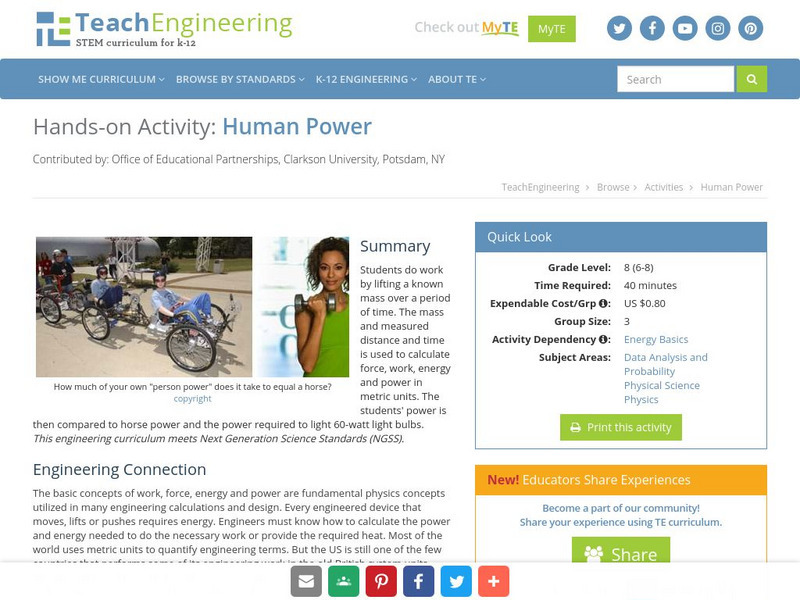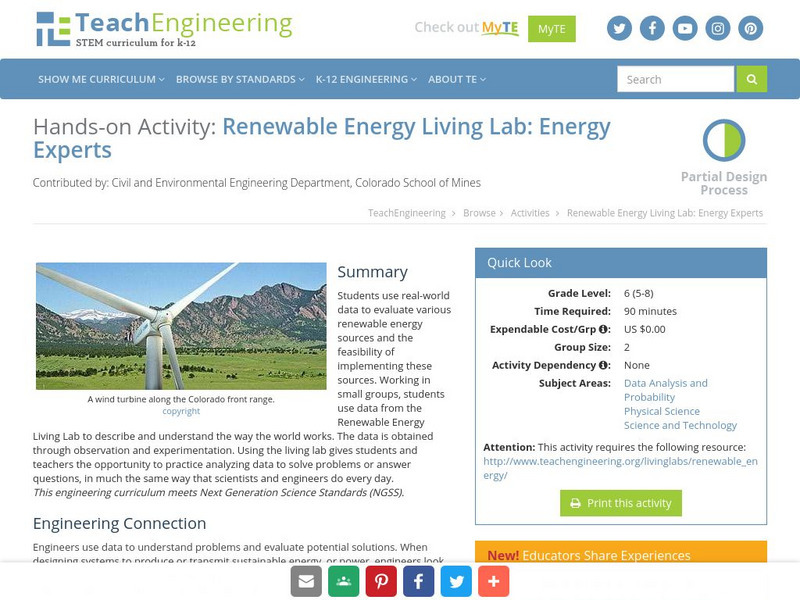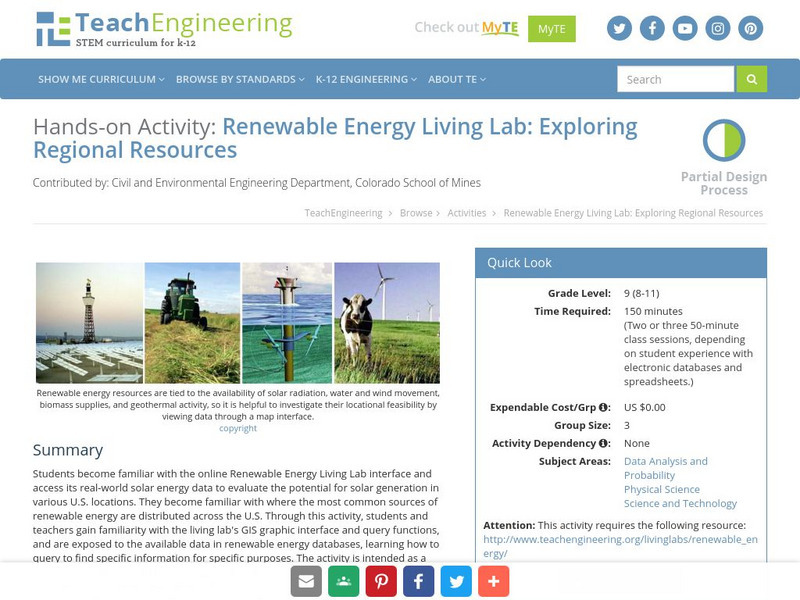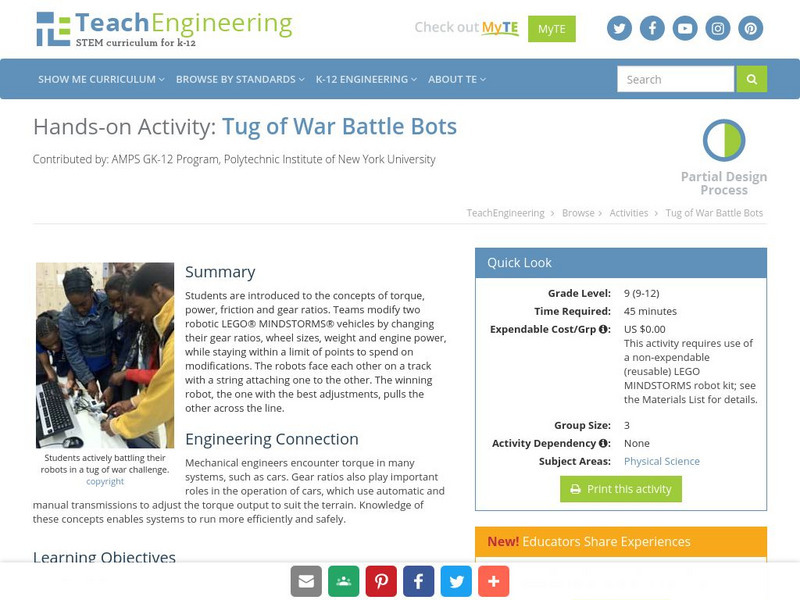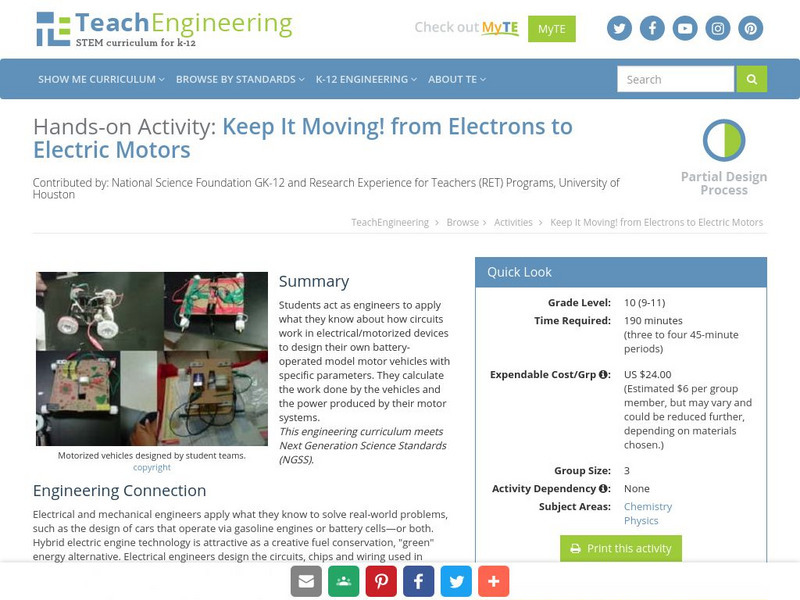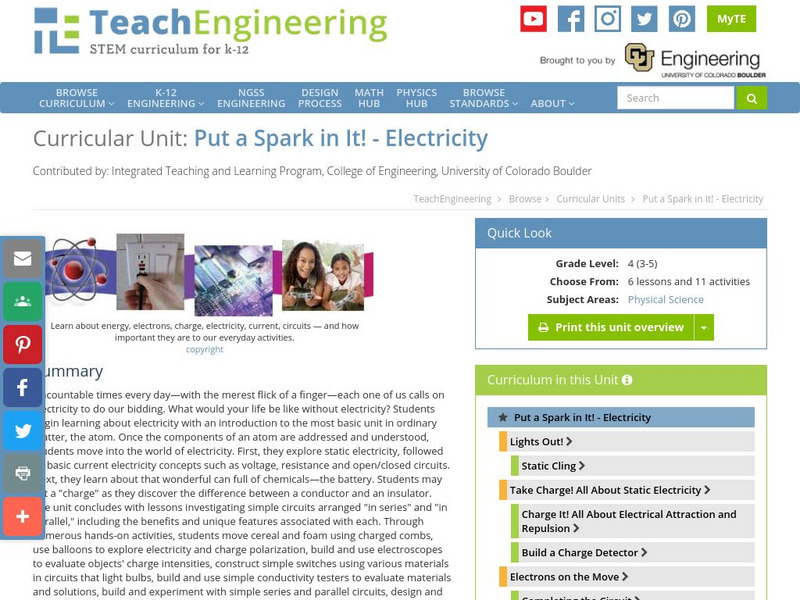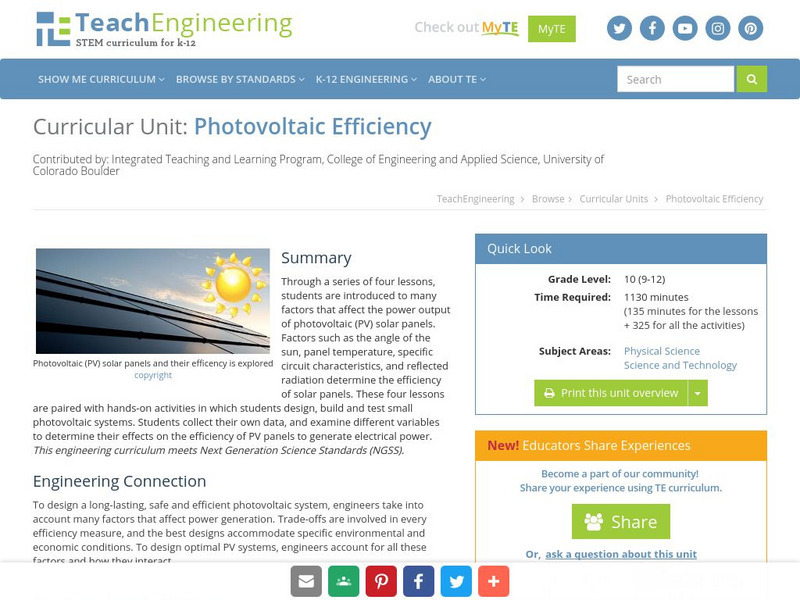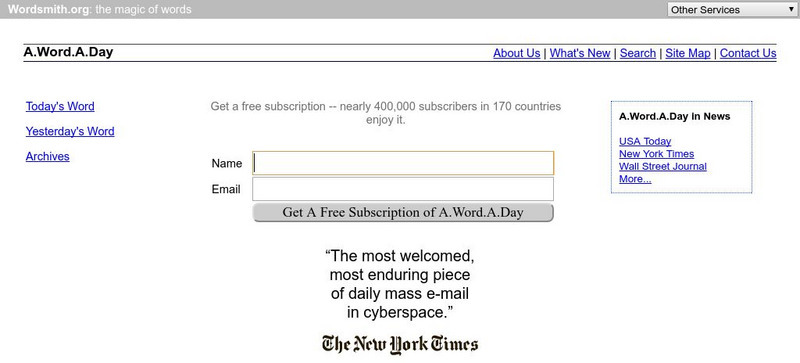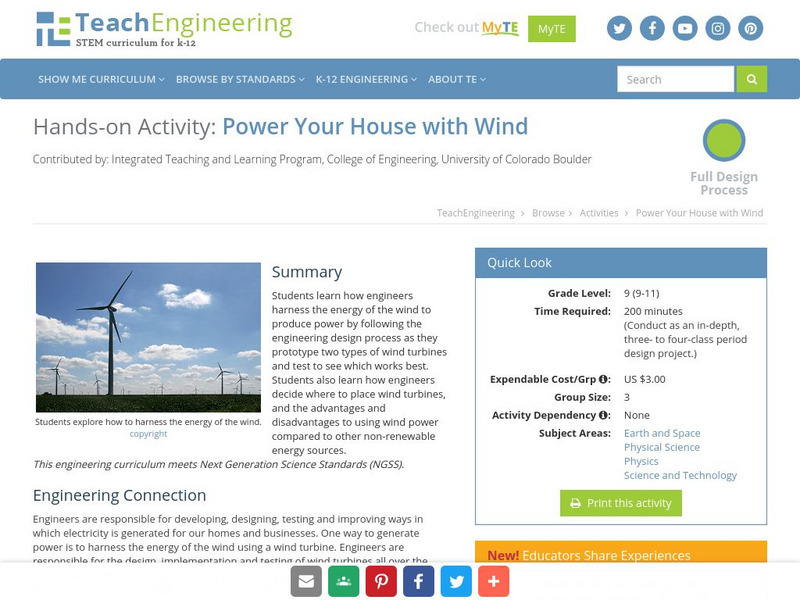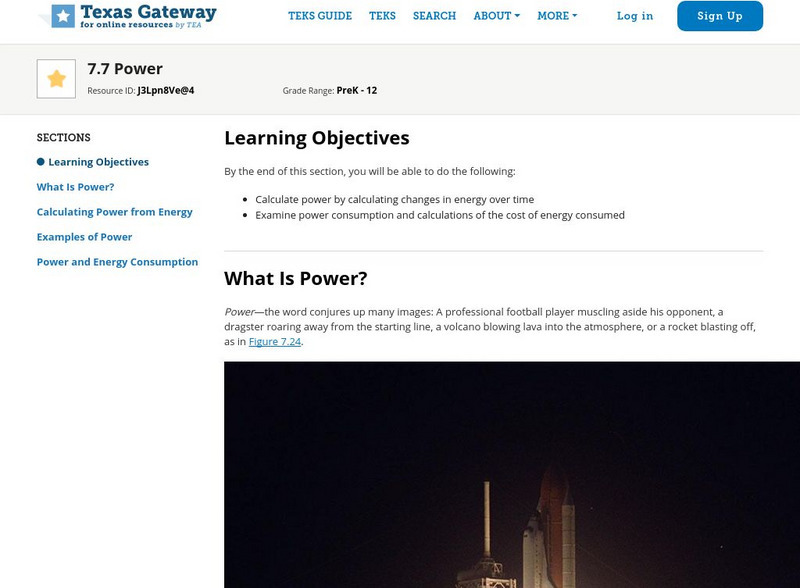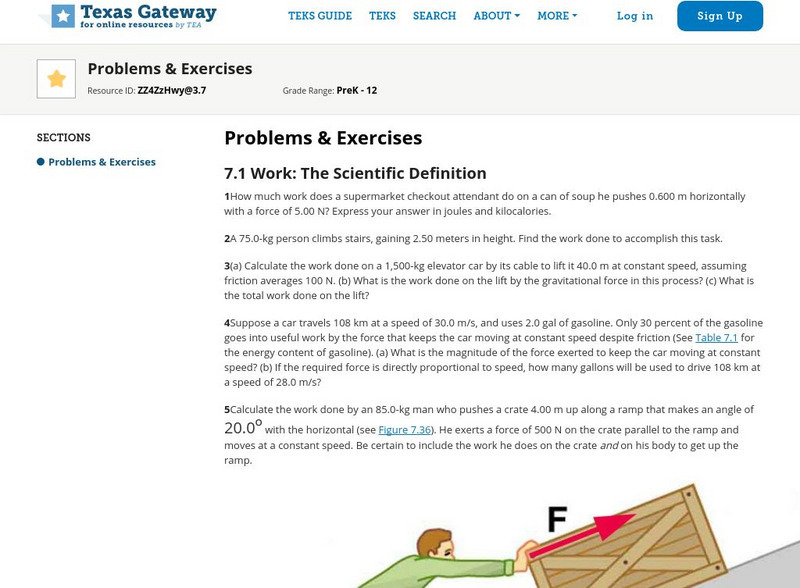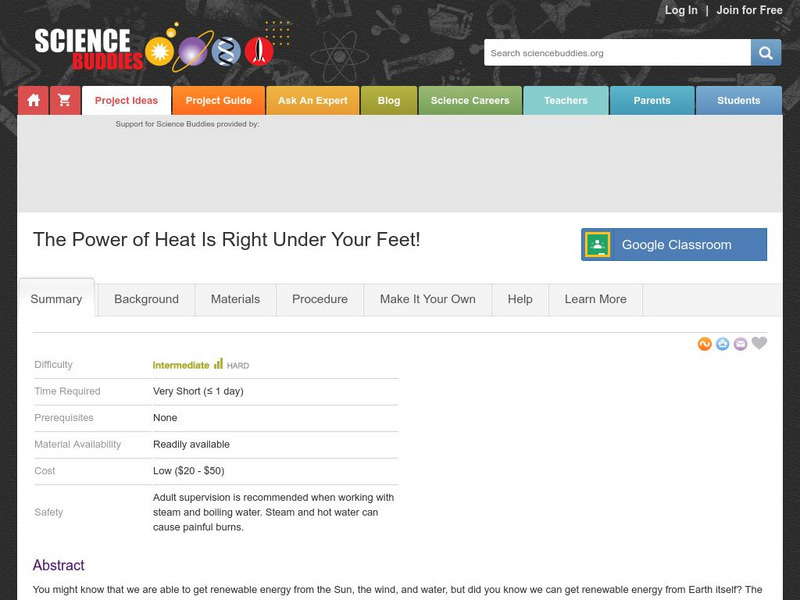TeachEngineering
Teach Engineering: Human Power
Students do work by lifting a known mass over a period of time. The mass and measured distance and time is used to calculate force, work, energy and power in metric units. The students' power is then compared to horse power and the power...
TeachEngineering
Teach Engineering: Renewable Energy Living Lab: Energy Experts
Students use real-world data to evaluate various renewable energy sources and the feasibility of implementing these sources. Working in small groups, students use data from the Renewable Energy Living Lab to describe and understand the...
TeachEngineering
Teach Engineering: Renewable Energy Living Lab
Students become familiar with the online Renewable Energy Living Lab interface and access its real-world solar energy data to evaluate the potential for solar generation in various U.S. locations. They become familiar with where the most...
TeachEngineering
Teach Engineering: Tug of War Battle Bots
Students are introduced to the concepts of torque, power, friction and gear ratios. Teams modify two robotic LEGO vehicles by changing their gear ratios, wheel sizes, weight and engine power, while staying within a limit of points to...
TeachEngineering
Teach Engineering: Keep It Moving! From Electrons to Electric Motors
Students act as engineers to apply what they know about how circuits work in electrical/motorized devices to design their own battery-operated model motor vehicles with specific paramaters. They calculate the work done by the vehicles...
TeachEngineering
Teach Engineering: Put a Spark in It! Electricity
Uncountable times every day "with the merest flick of a finger"each one of us calls on electricity to do our bidding. What would your life be like without electricity? Students begin learning about electricity with an introduction to the...
TeachEngineering
Teach Engineering: Energy
Through nine lessons, students are introduced to a range of energy types--electrical, light, sound and thermal-as well as the renewable energy sources of wind, hydro (water) and solar power. Subjects range from understanding that the...
TeachEngineering
Teach Engineering: Photovoltaic Efficiency
Through a series of four lessons, students are introduced to many factors that affect the power output of photovoltaic (PV) solar panels. Factors such as the angle of the sun, temperature of the panels, specific circuit characteristics,...
TeachEngineering
Teach Engineering: Household Energy Conservation and Efficiency
Students complete three different activities to evaluate the energy consumption in a household and explore potential ways to reduce that consumption. The focus is on conservation and energy efficient electrical devices and appliances.The...
TeachEngineering
Teach Engineering: Concentrated Solar Power
Students learn how the total solar irradiance hitting a photovoltaic (PV) panel can be increased through the use of a concentrating device, such as a reflector or lens. This is the final lesson in the Photovoltaic Efficiency unit and is...
Texas Education Agency
Texas Gateway: Power
Given diagrams, illustrations, scenarios, or relevant data, students will calculate the power of a physical system.
Other
A. Word. A. Day
Still another site offering you a word a day to build vocabulary and understanding of new words. You can subscribe for free, or check out the archives.
Other
Uso Eficiente De Energia Electrica
Learn about the efficient use of electric energy in Spanish. See the products and services responsible for saving energy.
NBC
Nbc Learn: Science of Golf
Collection of short original video clips uncovers the science, technology, engineering and math behind the game of golf. The video series features both scientists and pro golfers and lessons plans are provided to accompany the videos.
TeachEngineering
Teach Engineering: The Claw
Students learn about gear ratios and power by operating toy mechanical cranes of differing gear ratios. They attempt to pick up objects with various masses to witness how much power must be applied to the system to oppose the force of...
Science Struck
Science Struck: A Comprehensive List of All the Physics Formulas
Provides a long list of physics formulas for easy reference.
TeachEngineering
Teach Engineering: Power Your House With Wind
Students learn how engineers harness the energy of the wind to produce power by following the engineering design process as they prototype two types of wind turbines and test to see which works best. Students also learn how engineers...
TeachEngineering
Teach Engineering: Energy of Motion
By taking a look at the energy of motion all around us, students learn about the types of energy and their characteristics. They first learn about the two simplest forms of mechanical energy: kinetic and potential energy, as illustrated...
CK-12 Foundation
Ck 12: Power
[Free Registration/Login may be required to access all resource tools.] This online tutorial asks students to calculate the mechanical energy of power generated within a physical system.
Texas Education Agency
Texas Gateway: Ap Physics: Power
By the end of this section, you will be able to calculate power by calculating changes in energy over time and to examine power consumption and calculations of the cost of energy consumed.
Texas Education Agency
Texas Gateway: Work, Energy, and Energy Resources: Problems & Exercises
This is a list of 74 problems/exercises to solve over the content of Chapter 7: Work, Energy, and Energy Resources from the AP Physics online text.
Texas Education Agency
Texas Gateway: Work, Energy, and Energy Resources: Summary
This is a summary of the information in Chapter 7: Work, Energy, and Energy Resources for the AP Physics I course online.
Science Buddies
Science Buddies: The Power of Heat Is Right Under Your Feet!
You might know that we are able to get free energy from the Sun, the wind, and water, but we can also get free energy from Earth itself. This source of energy is called geothermal energy and it is all about taking advantage of the heat...
Science Buddies
Science Buddies: Build Your Own Windmill Generator
Build your own windmill and see how the wind can be converted into energy to produce electricity. This science fair project should help you understand the use of wind as a source of alternative energy. The Science Buddies project ideas...


